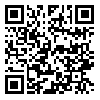Volume 29, Issue 2 (7-2023)
Back to this Issue |
Back to browse issues page
Download citation:
BibTeX | RIS | EndNote | Medlars | ProCite | Reference Manager | RefWorks
Send citation to:



BibTeX | RIS | EndNote | Medlars | ProCite | Reference Manager | RefWorks
Send citation to:
Keshmiri F, Bahramnezhad F. The role of hidden curriculum in the formation of professional identity among undergraduate nursing students. Journal of Hayat 2023; 29 (2) :171-185
URL: http://hayat.tums.ac.ir/article-1-4910-en.html
URL: http://hayat.tums.ac.ir/article-1-4910-en.html
1- Dept. of Medical Education, School of Public Health, Shahid Sadoughi University of Medical Sciences, Yazd, Iran
2- Dept. of Nursing Critical Care, School of Nursing and Midwifery, Tehran University of Medical Sciences, Tehran, Iran; Nursing and Midwifery Care Research Center, School of Nursing and Midwifery, Tehran University of Medical Sciences, Tehran, Iran ,bahramnezhad.f@gmail.com
2- Dept. of Nursing Critical Care, School of Nursing and Midwifery, Tehran University of Medical Sciences, Tehran, Iran; Nursing and Midwifery Care Research Center, School of Nursing and Midwifery, Tehran University of Medical Sciences, Tehran, Iran ,
Abstract: (906 Views)
Background & Aim: Various factors play a significant role in shaping the professional identity of nursing students, and among these factors, the impact of the hidden curriculum holds utmost importance. However, this process remains still unknown. The aim of the study is to explore the role of hidden curriculum in the formation of professional identity among undergraduate nursing students.
Methods & Materials: This is a qualitative research using the grounded theory approach. The participants in this study included 35 undergraduate nursing students from Tehran University of Medical Sciences during the 2020-2021 academic year who participated in semi-structured interviews. The interviews lasting between 30 and 60 minutes were conducted with each participant. Subsequently, the interviews were transcribed and analyzed following the framework proposed by Strauss and Corbin in 2008.
Results: After analyzing the data, three main categories and 12 subcategories have emerged. The theory developed in this research was formed through the core category of “identity instability within the nursing profession”. The main categories that emerged were “ambiguity and lack of motivation in professionalization”. The study identified "the governance of a discriminatory culture" as the underlying process, while “the promotion of demotivation resulting from inefficient patterns” served as the basis of this study.
Conclusion: Based on the study's findings, the process of developing a professional identity can be metaphorically likened to a river. In this analogy, discrimination serves as the clouds hovering over this river, casting a shadow on the identity development process. While inefficient patterns can be likened to lightning bolts that further complicate the process. Furthermore, the rocky bed of the river, symbolizing the lack of motivation among learners towards professionalism, makes it even more challenging to build a strong professional identity.
Methods & Materials: This is a qualitative research using the grounded theory approach. The participants in this study included 35 undergraduate nursing students from Tehran University of Medical Sciences during the 2020-2021 academic year who participated in semi-structured interviews. The interviews lasting between 30 and 60 minutes were conducted with each participant. Subsequently, the interviews were transcribed and analyzed following the framework proposed by Strauss and Corbin in 2008.
Results: After analyzing the data, three main categories and 12 subcategories have emerged. The theory developed in this research was formed through the core category of “identity instability within the nursing profession”. The main categories that emerged were “ambiguity and lack of motivation in professionalization”. The study identified "the governance of a discriminatory culture" as the underlying process, while “the promotion of demotivation resulting from inefficient patterns” served as the basis of this study.
Conclusion: Based on the study's findings, the process of developing a professional identity can be metaphorically likened to a river. In this analogy, discrimination serves as the clouds hovering over this river, casting a shadow on the identity development process. While inefficient patterns can be likened to lightning bolts that further complicate the process. Furthermore, the rocky bed of the river, symbolizing the lack of motivation among learners towards professionalism, makes it even more challenging to build a strong professional identity.
Send email to the article author
| Rights and permissions | |
 |
This work is licensed under a Creative Commons Attribution-NonCommercial 4.0 International License. |






